Development of Technology to Assess Water Shortage Risk and Secure Water for Small-Medium Rivers in Response to Drought
Development of Technology to Assess Water Shortage Risk and Secure Water for Small-Medium Rivers in Response to Drought
▲ Research Fellow Kim Chul-gyum, KICT Department of Hydro Science and Engineering Research
Prologue
Drought in Korea takes place every five to year years, statistically, and recently its occurrence and damage have become more frequent due to climate change. Aggravation of water shortage in the future, which is predicted according to climate change and increase in water consumption, will adversely affect water quality and aquatic ecosystems as well as water supply problems. In particular, the watersheds of small-medium rivers have a low ability to respond to water shortages from the drought and face repeated deterioration of the water quality and ecological environment due to water shortages. Furthermore, it is difficult for them to secure water supply through dams or reservoirs and control the flow of the rivers. Accordingly, measures for continuous water management, considering stable water security and water quality, are required for them.
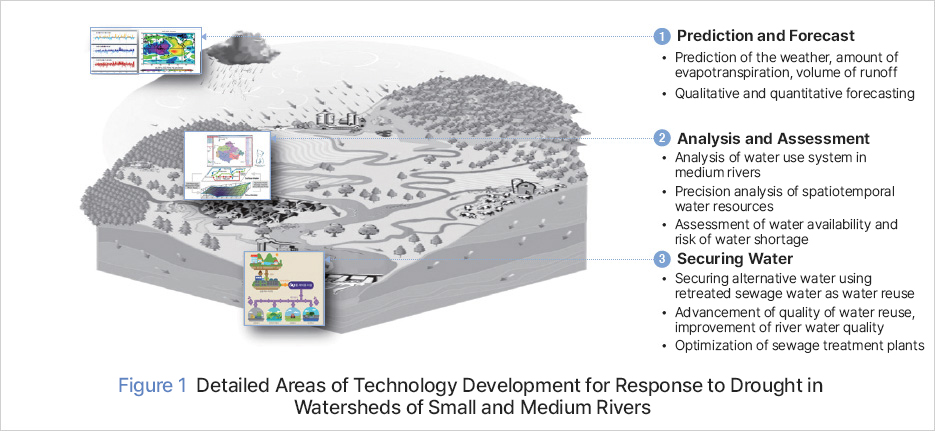
For effective drought response, accurate analysis and assessment of available water resources, along with rainfall prediction, and efficient water supply that can reduce the risk of water shortage based on this are required. As one of the alternatives for securing water, the reuse of sewage re-treated water is attracting attention, but the actual recycling rate is less than 20% due to concerns about the quality of reused water and aesthetic rejection. Accordingly, in order to increase the utilization rate of reused water, it is necessary to further strengthen the treatment level for water quality, while securing a safe level of water quality for various new hazardous substances that are not yet subject to regulation. In addition, in the case of small-medium rivers, eutrophication or algae is more likely to occur due to nutrients in the effluent because the amount of water discharged from the sewage treatment plant accounts for a large proportion of the river flow during drought. Therefore, it is necessary to highly upgrade the water quality treatment level for the water discharged from sewage treatment plants in order not only to secure the water quality safety of reused water but also to protect river water quality during drought.
In order to solve the problems in terms of quantity and water quality that can occur in the watersheds of small-medium rivers during drought, in this study the Korea Institute of Civil Engineering and Building Technology (KICT) developed detailed technologies in three major areas, as shown in Figure 1. In the field of prediction/forecasting, we developed a technology for predicting the weather, amount of evapotranspiration, volume of runoff, etc. In the field of analysis/assessment, we developed a precision spatiotemporal hydrological analysis technology that reflects the complex water use system and physical characteristics of the watersheds of small-medium rivers; this assesses water resources availability and risk of water shortage. To secure water, we developed an advanced treatment technology for water reuse in sewage treatment plants and economical treatment technology that are superior to previous treatment processes. We also developed a technology that can dramatically reduce sludge and eutrophication-inducing substances generated in the sewage treatment process.
Long-term Prediction Technology for Weather and Hydrologic Volume
From a meteorological point of view, long-term prediction on a time scale ranging from one month to several months is essential information for securing and managing stable water resources and securing agricultural productivity in response to meteorological disasters, such as drought, flood, heat waves, and cold waves. Long-term prediction is mainly made by statistical models and climate models. However, it has not yet secured a sufficient level of predictability, and it is an area where attention and research have been continuously focused on in recent years. The Korea Meteorological Administration also provides forecast data for one to three months on precipitation and temperature using the results of the global climate model, which is a dynamical model. However, due to the geographical characteristics of the Korean Peninsula, sudden heavy rains or typhoons and abnormal climatic conditions have become more frequent than in the past. That is why it is not easy to accurately predict the weather.
In this study, we developed a statistical model that can predict the monthly precipitation and temperature for the next one to twelve months in the Han River Sphere. We configured the prediction mode by flexibly selecting the optimal predictive parameters according to the prediction month based on the teleconnection between prediction target meteorological parameters (precipitation, temperature) and global climate patterns, making it possible to reflect meteorological and climate variability according to future climate change, etc. The forecasted monthly weather information is converted into the daily data for each major point by using the statistical downscaling technique, and the converted daily data are linked with the hydrological model. In this way, the forecasting results for hydrological parameters, such as the amount of evapotranspiration or volume of runoff, for the next 12 months also can be derived in the same way as the weather forecast period.
Predicted weather and hydrologic volume information are provided through a web-based system as shown in Figure 2. Currently, monthly forecast information is being provided for the monthly precipitation, average temperature, and reference amount of evapotranspiration in the Han River Sphere, as well as the volume of runoff in the Chungju Dam watershed and the Gyeongancheon watershed. In addition, the forecast results ranging from December to the latest forecast results are being provided. Moreover, the forecast results ranging from those for January to December 1991, which were predicted based on December 1990, to the latest forecast results are provided.
Precision Hydrologic Analysis and Assessment Technology for Small-Medium Rivers Watersheds
Compared to the wide-area water supply regions around large rivers, water supply stability in small-medium river watersheds is relatively vulnerable during drought. Therefore, reliable prediction of the volume of runoff or available water resources is required in order to prepare comprehensive measures, such as the efficient operation of water supply facilities, assessment of water supply risk, and optimal use of available water resources. To this end, in this study we developed a water shortage risk assessment and water resources capacity assessment technology that reflects the detailed water use system (groundwater intake/drainage, sewage/wastewater discharge, etc.) and hydrological environment characteristics in watersheds during drought (Figure 3).
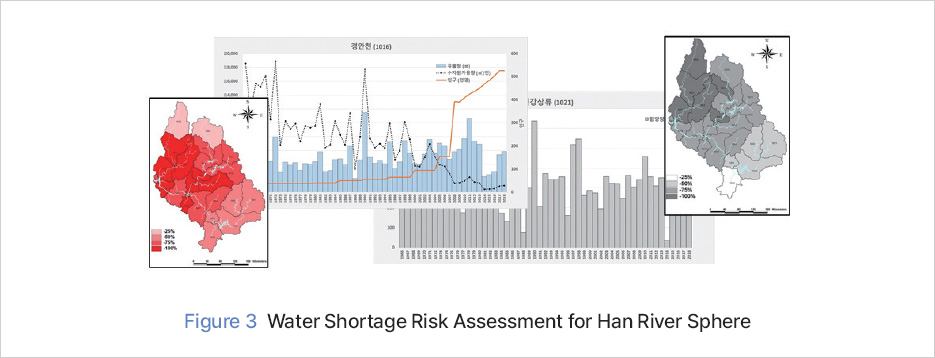
By utilizing the developed technology, we have identified the impact of underground water intake on the accuracy of the prediction of the volume of runoff of the river watersheds for the first time in Korea. In addition, we laid the foundation for practical use to support the policies of the Ministry of Environment and local governments for the water management during drought by securing more than 70% predictive accuracy for the developed technology for each sphere of the medium-sized rivers, including Han River, Nakdong River, Geumgang, Yeongsan River, and Seomjin River. Furthermore, we developed a dynamic water resources assessment tool (DWAT), a program to assess the hydrological volume for small-medium rivers, and released it on the World Meteorological Organization (WMO) website in 2019. In June 2019, the WMO Hydrological Assembly decided that the DWAT would support the pilot project of "Global Hydrological Status and Forecasting System (HydroSOS)." In 2021, the DWAT was applied to sites in four Member States (Colombia, Argentina, the United Kingdom, and river watersheds in Bhutan). The research team continues to provide technical support related to the application and education of the DWAT through the WMO Technical Advisory Project (Figure 4).
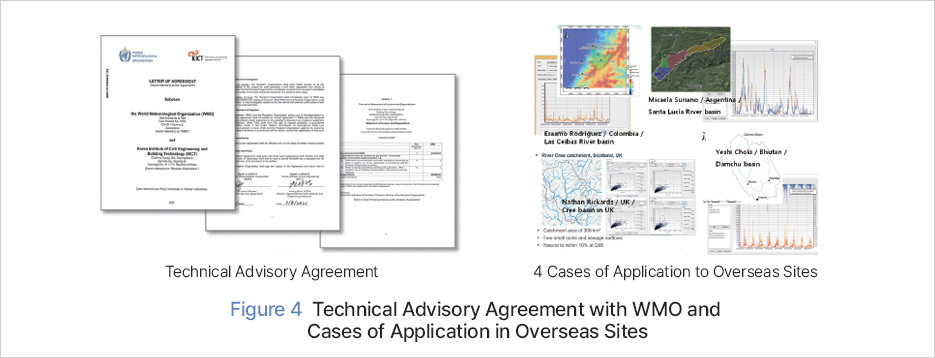
Technology for Advanced Treatment of Recycled Water Based on Advanced Oxidation
Reuse of water refers to recycling the sewage and wastewater, heavy water, or stormwater that have been retreated through an appropriate water treatment technology, as water that meets the purpose of use. Reuse of water, in addition to reducing the amount of water source used, also offers benefits such as a cutdown of discharge of pollutant loads to public waters. Consequently, the need for the reuse of water is growing in terms of improving water scarcity and creating a healthy water environment. Meanwhile, it was found that new and trace pollutants/contaminants which are of concern as being hazardous to the human body or ecosystem, such as chemicals and pathogenic microorganisms, may remain in the reuse water. Accordingly, a technology for producing recycled water that can ensure the safety of reused water is required. In this study, we developed a UV-based advanced oxidation treatment process that can effectively treat residual trace organic pollutants by utilizing the TOC item newly added to the effluent water quality standards from 2020 as an index. We also secured the technology for recycling re-treated sewage water. By reducing the TOC concentration to 2.3-4.4mg/L in the secondary treated water of sewage, we have developed a process that can re-treat the sewage water, which has gone through secondary treatment, up to the level of Ib to III grade (the level that can be used as water for residential water) on the river living environment of the TOC standards. Furthermore, we secured a preemptive response technology for the treatment of unregulated new pollutants as well in order to secure the safety of recycled water, which is not currently regulated. For this, the ozone treatment process developed using a vortex-type microbubble generator was applied to 23 pharmaceuticals, including antibiotics, which are highly likely to be regulated in the future. As a result, it was confirmed, as shown in Figure 5, that pharmaceuticals can be reduced by more than 80%, and perfluorooctanesulfonic acid (PFOS), a representative material of perfluorinated compounds, can be cut down by 43%.
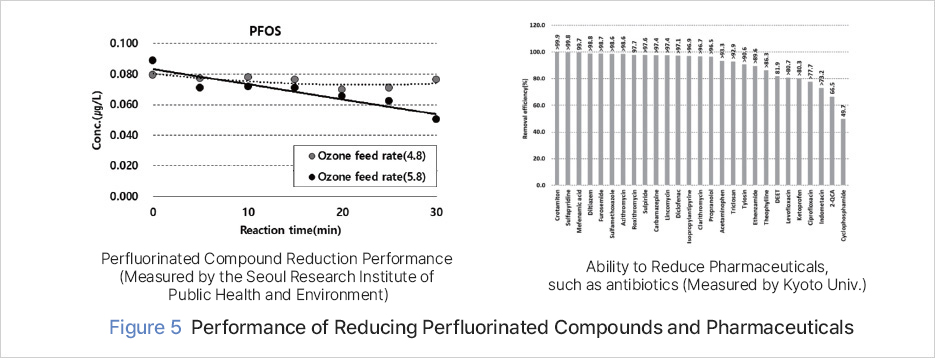
Technology for Reuse of Sewage-treated Water with Low Energy
In order to promote the use of recycled water, it is necessary to secure the safety of water quality and to develop an economical water supply plan. Korea reuses about 1 billion m3, which is 14.7% of the total sewage water treatment volume, and it is mainly used for washing water in the treatment plant, water for other uses, and water used to maintain the level of river water (74% of off-site water) (Ministry of Environment, 2015). This is because sewage-treated water effluent can be utilized directly without further treatment.
In Korea, the ozone-based advanced oxidation process and membrane-based reverse osmosis (RO) process are mainly used for treatment processes for use as industrial water and agricultural water. In the case of the RO process, where membrane technology is widely used, 44% of the cost of operation and management is shown to be the energy cost for maintaining a high pressure of 12-19 bar or higher. On the other hand, the capacitive deionization (CDI) process used for seawater desalination is a technology that adsorbs ionic substances in the water onto an electric double layer, generated through electricity applied to a porous electrode composed of a dual-module, and treats them. It is known that its ion removal rate is lower than that of the RO process but the energy consumption is comparably lower.
In this study, we developed a low-pressure membrane (UF)-CDI process linking an ultrafiltration membrane and CDI to derive an optimal process that can treat water meeting the target water quality level and save energy. It was compared with the target TOC concentration of 5 mg/L and confirmed that it was possible to treat up to a level of 3.62 mg/L. And in terms of energy, it was analyzed that the maintenance cost could be reduced by about 30% or more compared to that of the conventional RO process (Figure 6). Hence, it will increase the treatment efficiency of recycled water along with the ozone/ultraviolet advanced oxidation treatment process and secure sufficient water quality safety, thereby contributing to reducing the rejection of recycled water and increasing its utilization rate.
Technology for Removal of Phosphorus in Water without Generation of Sludge and Recovery
The nutrients contained in the sewage treatment water, including phosphates, cause eutrophication in rivers and dams, resulting in deterioration of water quality. Conventionally, the removal of phosphate contained in water has been centered on chemical treatment methods, such as rapid stirring - slow stirring - precipitation using ferric salts or aluminum. This method has a problem in that the cost of treating sludge is high due to the excessive generation of chemical sludge. Accordingly, several researchers are trying to remove phosphorus without generation of sludge by using iron components, such as iron ore, slack, and zero-valent iron, as an adsorbent for phosphate removal, but the removal efficiency is not high and the reaction time is excessively long (more than four hours). In this study, we developed the world's first sludge-free phosphate-removing and adsorbing new material to solve this problem and derived an optimal method to produce fertilizer using the removed phosphate (Figure 7). To assess the performance of the developed adsorption material, the adsorption/desorption process was repeated about 65 times. As a result, the component in the treated water was not detected at all, or it was found to be less than 0.03 mg/L, which is about 1/10 of the current water quality standard. In addition, in terms of maintenance, the net construction cost is similar to that of the conventional process (PAC+DAF)1) based on the treatment capacity of 1,000 m3/day, but the chemical agent consumption cost is found to be 1/30. It was analyzed that the economic feasibility was also excellent as 240 kg of phosphate fertilizer per month could be produced as a by-product.
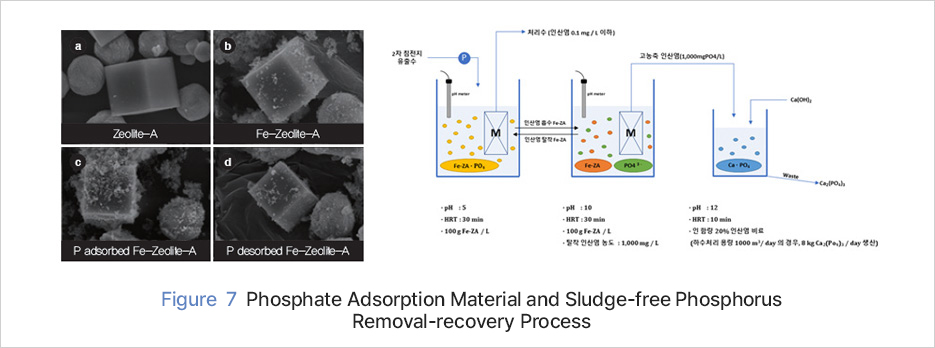
Technology for Crystallization of MAP to Recover Phosphorus and Nitrogen from Side Streams of Sewage Treatment Plants
The average amount of water discharged from public sewage treatment plants in Korea is about 19 million m3 per day as of 2015. For watersheds of small-medium rivers like Gyeongancheon Stream, this represents a good amount of water resources, accounting for more than 70% of the quantity of flow during the low-water season. However, nutrient substances such as phosphorus and nitrogen remain in the effluent, which is highly likely to cause eutrophication and algae growth in rivers and lakes. Meanwhile, the side streams (or reject water) containing high concentrations of phosphorus and nitrogen from the sewage treatment plant are returned to the grit chamber and this rapidly increases the load of phosphorus and nitrogen in the subsequent biological treatment process, thereby ultimately lowering the water quality of the effluent.
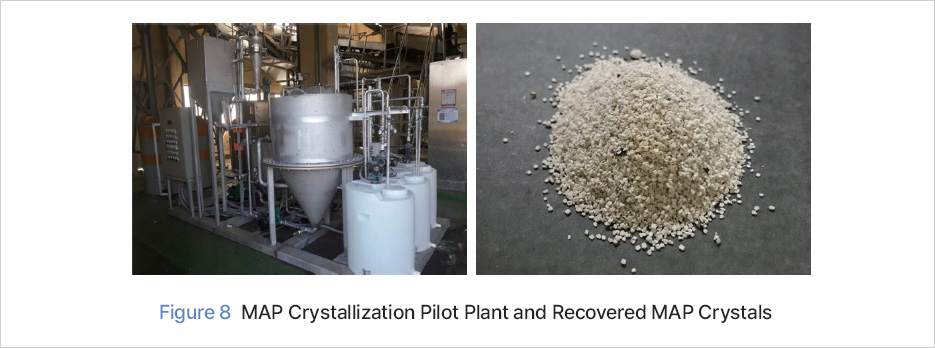
In this study, we developed a new process for crystallization of MAP (Magnesium Ammonium Phosphate) that can dramatically remove and recover nutrients, such as phosphorus and nitrogen in side streams, generated from sewage treatment facilities. In addition, the recovered MAP crystals can be used as a controlled release fertilizer (Figure 8). Design and optimal operating parameters were derived through the operation of a demonstration plant for the developed MAP crystallization process, and the basis for practical use was established through operation and maintenance manuals. The new MAP crystallization process secured more than 90% efficiency in removing phosphorus (PO4-P) in side streams by using sewage sludge incineration ash and recovering high-concentration effluent. And it raised the efficiency of removing nitrogen (NH4-N), which was on average 20% in the conventional MAP crystallization process, to more than 80%. Furthermore, it minimized the cost by using a single MgO chemical agent in the treatment process, and sufficient economic feasibility was secured for practical use by recovering MAP crystals that can be used as fertilizers. The developed new process will dramatically cut down the amount of phosphorus and nitrogen, which are circulating at high concentrations in the side streams, thereby reducing the load on the follow-up treatment processes and ultimately contributing to the protection of the water quality of the river to which it is discharged.
Epilogue
After five years of close study, core technology was secured for drought countermeasures in watersheds of small-medium rivers (Figure 9). In the field of prediction/forecasting, we laid the foundation to enhance the utility of preemptive drought forecasting and prediction information by developing quantitative forecasting technology for meteorology and hydrology and establishing a web-based service system that can provide long-term forecasting results. For analysis/assessment, we developed technology for precise spatiotemporal hydrological analysis and assessment, laying the groundwork for decision support for local governments in Korea to establish drought countermeasures. In addition, we established the foundation for global application and technical support by distributing it to major overseas WMO member states. In the field of response/security, we sought preemptive response to unregulated hazardous substances, provision of technical support for water treatment facilities, and enhancement in the value of the use of alternative water resources by developing advanced and low-energy treatment processes for the use of sewage recycled water. Moreover, we laid the foundation for not only protecting river water quality but also generating profits through the recycling-to-resources, via the sludge-free nutrient reduction technology as well as the recovery and crystallization technology. Regarding long-term forecasting technology, we continue to provide meteorological and hydrological forecasting information for the Han River Sphere through our website. The technology for hydrological analysis and assessment has been adopted as the main model of WMO and technical support is being provided to several member states. The reuse-water production technology is being considered for the application to the process improvement project of the wastewater treatment plants by the companies to whom the technology was transferred. The nutrient material treatment technology is also in the process of technical explanations and consultations at the working group level with related companies for each core process.
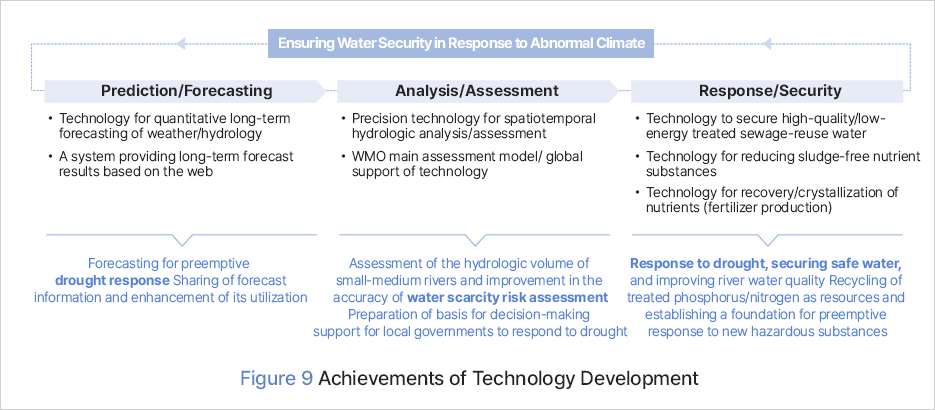
The various detailed technologies developed in this study will be able to contribute to creating a healthy water environment, as well as securing stable and safe water resources for the watersheds of small-medium rivers, which have been relatively vulnerable to drought response.